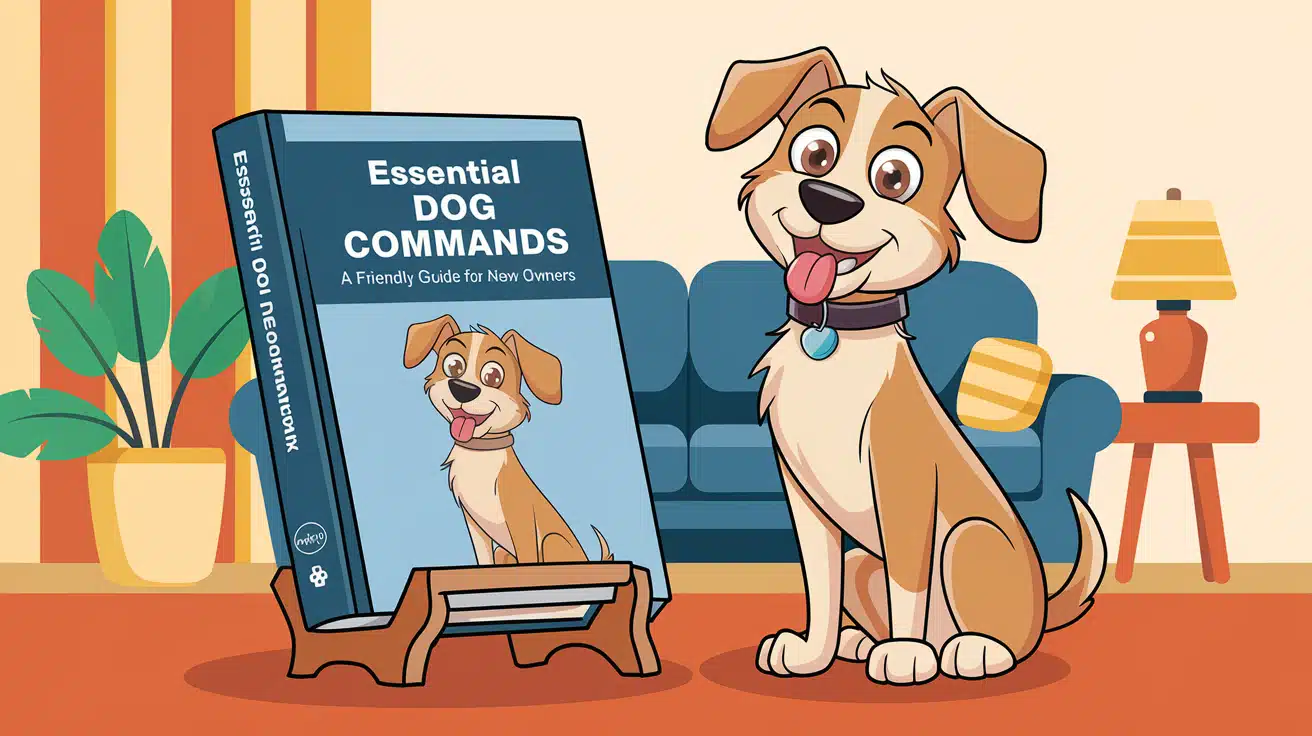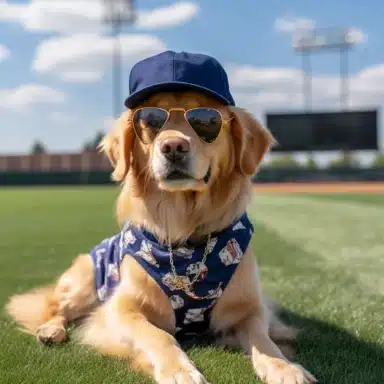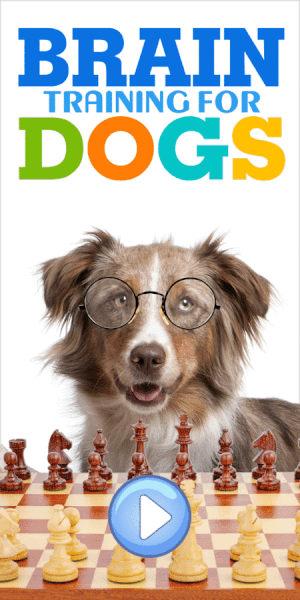Essential Dog Commands. Getting a new dog can be exciting and a bit overwhelming, especially when it comes to training. Teaching essential commands not only helps keep a dog safe but also strengthens the bond between a dog and its owner.
Command training is crucial because it helps create a well-behaved and happy canine companion.
Understanding basic commands like “sit,” “stay,” or “come” can make daily interactions smoother and more enjoyable.

Imagine walking with your dog in the park. Suddenly, another dog appears, and your pup starts to bark excitedly.
With the right training, a simple “sit” or “stay” can calm the situation immediately.
This is why understanding essential commands is so important. They provide structure and predictability, helping dogs feel secure in their environment.
For many new dog owners, discovering effective ways to train their pets might seem tricky.
Yet, with patience and the right techniques, anyone can teach their furry friend important commands.
By using positive reinforcement and consistency, training can transform chaos into harmony, reflecting the beauty of a well-behaved animal. Visit this engaging dog training guide for more insights.
Getting Started with Dog Training
Embarking on the journey of training your dog involves understanding their behavior and selecting the right tools. This helps in building a positive learning environment for both the owner and the dog.
Understanding Dog Behavior
Before diving into training methods, it’s important to observe your dog’s natural actions and reactions.
Dogs communicate through body language, sounds, and facial expressions.
Recognizing signs of stress, excitement, or curiosity can guide you in choosing the best training approach.
For instance, a wagging tail and perked ears often indicate eagerness, which is a great time for training.
Training uses positive reinforcement to encourage good behavior. When a dog successfully follows a command, rewarding them with a praise or a treat reinforces that behavior.
Many trainers suggest using high-value treats as they are more enticing to dogs and motivate them more effectively.
Remember that dogs, like humans, have their unique personalities, so a method that works for one dog might not work for another.
Consistent training, tailored to your dog’s behavior, will yield the best results.
Choosing the Right Training Tools
Equip yourself and your dog with tools that enhance the training process.
Clicker training is a popular choice; it uses a small device that makes a clicking sound to mark correct behavior, which is then followed by a treat. This technique is clear and precise, making it easy for dogs to understand.
Training treats are essential. They should be small, soft, and easy to consume quickly.
Some dog owners opt for using part of their pet’s regular meal to avoid overfeeding.
Consistency is key; regular, short training sessions help prevent fatigue and maintain engagement.
They can also consider hiring a professional dog trainer for added guidance, especially if they encounter challenges.
By choosing the right tools and sticking to a regular routine, positive results are within reach.
Mastering Basic Commands
Training a dog to follow basic commands is crucial for fostering a stronger bond between the owner and the pet. Each command serves a unique purpose. From telling your dog to sit and stay, to recalling them with a simple cue or ensuring safety with “leave it”, these commands are building blocks of effective dog communication.
The ‘Sit’ Command
Teaching a dog the “sit” command is often the first step in obedience training. It’s a simple command that lays the groundwork for other commands.
Imagine trying to calm a jumping, excited puppy with just a word.
“Sit.”
By associating this word with a treat or praise, dogs learn to respond eagerly.
Start by holding a treat close to the dog’s nose.
Slowly move your hand up, so the dog naturally follows it with their head, causing their bottom to lower.
Once they sit, say “sit,” give the treat, and share some loving words.
Repeating this can lead to a well-mannered pup who is ready for more advanced tasks.
The benefits of mastering this command are clear. A dog that understands “sit” can learn other dog commands like “stay” or “down” much more effectively. It plays an integral role in their overall training.
The ‘Stay’ Command
The “stay” command helps keep a dog safe in situations where they might be tempted to dart off.
Picture a busy park with distractions everywhere. When a dog hears “stay,” they should remain in place until told otherwise, making outings more enjoyable and stress-free.
To train a dog to stay, begin with them in a sitting position.
Show your palm like a stop signal and say “stay.”
Take a step back, and if the dog holds their position, reward them with a treat and praise.
Increase the distance and duration gradually.
A reliable “stay” command is more than about obedience; it’s about ensuring the dog’s safety. Whether preventing them from chasing a squirrel or crossing a street, it’s invaluable in diverse scenarios.
The ‘Come’ Command
“Come” is one of the most significant basic commands, calling a dog back to their owner. It’s fundamental in scenarios where they might wander too far or are in potential danger.
Think of the joy in seeing a furry friend run back with enthusiasm after hearing their name followed by “come.”
Start training in a fenced, distraction-free area.
Call the dog’s name and say “come” in a cheerful tone while motioning towards yourself.
Reward them with praise and a treat upon their approach.
This command builds trust between the dog and the owner. They understand that coming back is positive and rewarding. A well-trained dog will respond promptly, ensuring their safety in various settings.
The ‘Down’ Command
The “down” command reinforces a calm and submissive state in dogs. Unlike “sit,” this requires them to lower their entire body.
A dog that can go “down” on command is less prone to nervousness and shows better impulse control.
Begin by asking the dog to sit.
Hold a treat close to their nose, lowering your hand to the floor.
As the dog follows the treat, their body should touch the ground.
Once in position, complement with “down,” and reward with a treat.
This command proves useful during mealtimes or when visitors arrive. It ensures the dog remains peaceful and less intrusive, leading to a more harmonious household dynamic.
The ‘Leave It’ Command
The “leave it” command is vital for a dog’s safety, especially when encountering unfamiliar objects or food.
Imagine a park filled with tempting scraps. “Leave it” can prevent mishaps, ensuring the dog’s well-being.
Initially, place a treat in your hand and say “leave it” as they try to get it.
Once they stop and focus on you instead, reward them with a different treat.
Gradually, use this command with more challenging distractions.
A dog that masters “leave it” displays impulse control and increased focus. This training command is especially helpful on walks where unexpected items can pose risks. Strengthening this teaches the value of self-restraint and skills essential for their safety.
Enhancing Obedience Training

Training dogs requires patience, but with the right techniques, any owner can see amazing results.
Developing consistent daily routines and proper leash manners are key components to making this journey successful.
Establishing Daily Routines
Dogs thrive on predictability. By setting a daily routine, they become more comfortable and obedient.
Start the day with a walk at the same time. Feed meals on schedule to reinforce structure. Consistent timing also helps with potty training.
It’s crucial to include training sessions in these routines.
Short, frequent sessions keep dogs engaged without overwhelming them. Use treats and praise to positively reinforce good behavior during these moments.
Imagine a dog feeling at ease because he knows what comes next. This predictability reduces anxiety and builds trust.
Routines also help dogs adjust to new skills like crate training.
It’s not just about repetition—it’s about creating a stable environment where learning feels safe and rewarding.
With routine, dogs understand expectations and respond better. A happy, well-adjusted dog is the end goal.
Developing Leash Manners
Leash training can be one of the biggest challenges for new dog owners.
It’s easy to feel rushed, but starting slow benefits both the handler and pet.
Begin in a calm, non-distracting location. Focus on keeping the leash loose.
A short tug serves as a gentle reminder if the dog pulls. Praise plays a big role when they walk nicely beside you.
Switching between leash and harness training can offer different control levels.
A harness often gives more control but doesn’t replace good manners.
Practice walking routines regularly, even inside, to set expectations.
View each walk as a learning opportunity. The goal is a relaxed walk, both for them and the owner, making every outing enjoyable.
Handling Behavioral Issues

Navigating a dog’s behavioral challenges can be daunting, but understanding the roots of these issues helps manage them effectively. By focusing on separation anxiety and excessive barking, owners can use positive reinforcement and consistent training techniques to improve their pet’s behavior.
Coping with Separation Anxiety
Separation anxiety in dogs can lead to destructive behavior and distress.
Why does it matter? Imagine coming home to torn furniture or neighbors complaining about constant barking.
Dogs feel anxious when left alone due to deep attachments to their owners.
Positive reinforcement can ease these feelings.
Rewarding calm behavior with treats or affection helps your dog feel secure even when you’re not there.
Training techniques like gradually increasing the time you spend away can desensitize your dog to absences.
Some dogs benefit from having a special toy or blanket that provides comfort.
Establish a routine that your dog can rely on. Even small steps, like leaving a radio on, can make your pet feel less isolated.
Veterinary support can also be important for severe cases.
Curbing Excessive Barking
Excessive barking is common in dogs and often signals boredom or stress.
Why’s this important? Think about the peace disturbed at odd hours or during quiet family times.
Training your dog with consistent commands reduces unnecessary barking.
Positive reinforcement plays a major role.
Praise your dog when they stop barking on command, and offer treats for good behavior.
Some owners find success by teaching their dogs a “quiet” command.
Dogs may bark to communicate needs or protect their territory. Understanding these triggers can help manage the behavior.
Regular exercise and mental stimulation can also reduce barking caused by pent-up energy or boredom, leading to a calmer pet.
The Importance of Socialization

Socialization is crucial for a dog’s development and lifelong happiness. It helps ensure that dogs grow up to be confident and well-behaved.
Interaction with different environments and beings is key.
Puppy Playdates and Interaction
Early social experiences can greatly shape a puppy’s personality.
Puppy playdates are a fun and effective way to introduce dogs to social settings. By playing with other puppies, they learn important social cues and develop friendly habits.
Why should new dog owners consider playdates?
Think of them as supervised play sessions that help prevent future behavior issues like aggression or excessive shyness. It’s like how kids learn to share by playing together.
Beyond playdates, regular interaction with various people and pets is vital.
Visiting places like parks or pet-friendly stores exposes puppies to new sights, sounds, and smells. This helps them adapt to different situations, reducing fear or anxiety.
A well-socialized puppy is more likely to grow into a well-behaved dog.
Introducing a puppy to vet visits and grooming appointments is another step in socialization.
According to Meraki Dogs, frequent, positive experiences at these places make future visits easier and less stressful, both for the dog and the owner.
Advanced Training Techniques

Training a dog at an advanced level involves incorporating activities that challenge both their mind and body.
Techniques like agility exercises and mastering complex commands can enhance a dog’s mental stimulation and obedience skills.
Agility and Mental Challenges
Agility training takes dogs through various obstacle courses, including jumps and tunnels.
It’s great for keeping dogs physically fit and mentally stimulated. It improves coordination and builds confidence as dogs learn to navigate different challenges.
Mental challenges also enhance their skills by including games that require problem-solving.
Puzzles and hide-and-seek games can be very effective.
Dogs need a combination of agility and mental exercises to stay sharp. Regular practice can prevent boredom and lead to a happier, healthier pet.
Learning Complex Commands
Once basic commands are mastered, it’s time to move on to advanced commands.
This can include tricks like “roll over,” “play dead,” or even retrieving specific items by name. Such commands not only solidify obedience but can strengthen the bond between the owner and the dog.
Training for these commands takes patience and consistency.
Dogs often learn faster through positive reinforcement, as they respond well to treats and praise. Breaking down complex commands into smaller steps can make them easier to learn.
Clicker training can be a useful tool, as detailed in dog training methods. It helps dogs understand what is expected quickly, leading to more successful training sessions.
Health and Nutrition in Dog Training
The success of dog training often hinges on health and nutrition.
A well-balanced diet provides the energy and focus dogs need for training sessions. High-value treats play a crucial role in reinforcing desired behaviors effectively.
Optimizing Your Dog’s Diet for Training
A dog’s diet can shape their learning experience.
Just like athletes, dogs need the right nutrients to fuel their bodies during training. Proper nutrition helps maintain energy levels and keeps them focused.
Imagine giving a marathon runner junk food before a race.
Dogs need proteins, fats, and carbohydrates for energy. Their meals should include lean meats, grains, and healthy fats. Fresh fruits and vegetables can offer essential vitamins and minerals.
High-value treats make a difference in training.
They’re rewards for a job well done. Treats like small bits of chicken or cheese can be irresistible.
Pet owners should experiment with different treats to find what excites their dog the most.
It’s not just about feeding them; it’s about understanding their needs and preferences. This approach creates a bond and fuels effective training. When dogs are healthy and well-fed, they perform better in training.
Selecting a Dog Trainer
Choosing a dog trainer is a vital step in guiding your dog toward good behavior. It’s about finding someone who knows their stuff and can make training enjoyable.
Evaluating Trainer Credentials
When evaluating a trainer’s credentials, consider what type of certification they hold. Certified trainers have usually completed a recognized program. This might mean they have studied aspects of dog training 101, like behavior modification and positive reinforcement techniques.
Ask the trainer about their experience and methods. Are they familiar with the commands you want your dog to learn?
A good trainer should offer references from past clients to vouch for their expertise.
Observe a session if possible. Seeing a trainer in action gives insight into their approach. Are both the dogs and owners engaged and happy?
This is a sign of an effective trainer who has built trust with their clients and canine companions.









